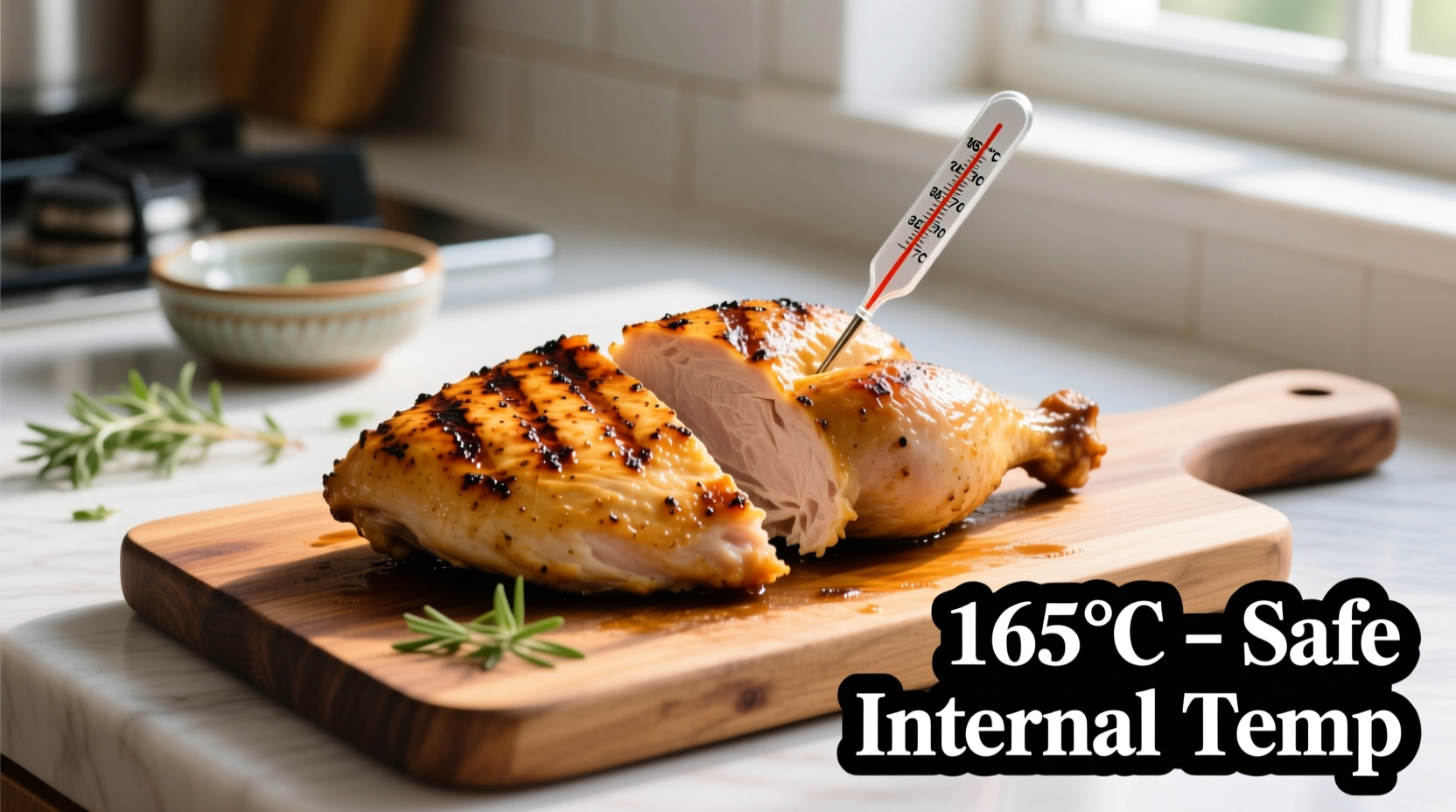Why Temperature Matters More Than Cooking Time
Many home cooks rely on cooking time or visual cues like "clear juices" to determine if chicken is done. These methods are dangerously unreliable. Food science confirms that only a properly calibrated food thermometer can verify chicken has reached a safe temperature. The USDA's Food Safety and Inspection Service emphasizes that 165°F (74°C) is the only reliable indicator that harmful pathogens have been destroyed.
| Poultry Product | Safe Minimum Internal Temperature | Resting Time After Cooking |
|---|---|---|
| All chicken cuts (breasts, thighs, wings) | 165°F (74°C) | 3 minutes |
| Ground chicken or turkey | 165°F (74°C) | 3 minutes |
| Stuffed chicken | 165°F (74°C) in both meat and stuffing | 3 minutes |
How to Properly Check Chicken Temperature
Using a food thermometer correctly is essential for accurate readings:
- Insert in thickest part - Avoid bone, fat, or gristle
- Check multiple spots - Especially for larger pieces or whole birds
- Wait 10 seconds - For digital thermometers to stabilize
- Sanitize between checks - Prevent cross-contamination

Common Temperature Myths Debunked
Several persistent myths about cooking chicken can lead to unsafe practices:
Myth: "The juices should run clear"
Research from the USDA shows that chicken can appear fully cooked (with clear juices and no pink) at temperatures as low as 140°F (60°C), well below the safe threshold. Conversely, properly cooked chicken may still show pink hues near bones due to myoglobin, a protein unaffected by cooking temperature.
Myth: "Resting time doesn't affect safety"
While resting time allows juices to redistribute, it does not continue killing bacteria. The USDA Food Code specifies that pathogens are destroyed only when the required temperature is reached and maintained. The 3-minute rest period after reaching 165°F serves texture purposes, not additional safety.
Special Considerations for Different Cooking Methods
While the target temperature remains constant, different cooking techniques require specific approaches:
Sous Vide Precision Cooking
When using sous vide methods, you can safely cook chicken at lower temperatures for extended periods. The FDA Food Code permits holding chicken at 145°F (63°C) for 8.5 minutes or 150°F (66°C) for 2.8 minutes to achieve the same pathogen reduction as 165°F instantaneously. This requires precise temperature control and timing that home cooks should approach with caution.
Smoking or Slow Cooking
The "danger zone" (40°F-140°F) concerns are critical with low-temperature methods. Ensure your smoker maintains at least 225°F-250°F to move chicken through the danger zone quickly. Always verify final internal temperature reaches 165°F regardless of cooking method.
Thermometer Selection Guide
Not all thermometers provide the accuracy needed for food safety:
- Digital instant-read - Most reliable for home use (±0.5°F accuracy)
- Leave-in probe - Excellent for roasting but requires proper placement
- Liquid-filled - Less accurate (±2°F) and slower response
- Dial oven-safe - Often inaccurate by 5-10°F; verify with ice water test
Calibrate your thermometer monthly using the ice water method (should read 32°F/0°C) or boiling water method (212°F/100°C at sea level).
What Happens Below 165°F?
Understanding the science behind the recommendation builds confidence in the guideline. Research from the USDA Food Safety and Inspection Service shows:
- At 140°F (60°C): Salmonella dies after 35 minutes
- At 150°F (66°C): Salmonella dies after 2.8 minutes
- At 160°F (71°C): Salmonella dies after 14.8 seconds
- At 165°F (74°C): Instant pathogen destruction
These time-temperature relationships explain why the USDA recommends 165°F as the practical safety standard for home cooking where precise timing is difficult.
Practical Tips for Perfectly Cooked Chicken
Follow these professional techniques to achieve safe, juicy results:
- Start with proper temperature - Remove chicken from refrigerator 20-30 minutes before cooking
- Use thermometer early - Begin checking temperature 5-7 minutes before expected finish time
- Account for carryover cooking - Remove chicken from heat at 160°F-162°F; it will rise to 165°F during resting
- Verify before serving - Always recheck temperature after resting period
When Slightly Lower Temperatures Might Be Acceptable (With Caveats)
While 165°F remains the official recommendation, food science shows context matters. The FDA Food Code allows for lower temperatures with precise time controls, but this requires professional equipment and knowledge. For home cooks, the margin for error makes 165°F the only practical recommendation. Special circumstances like sous vide cooking require strict adherence to time-temperature tables from authoritative sources like the CDC's cooking guidelines for groups.











 浙公网安备
33010002000092号
浙公网安备
33010002000092号 浙B2-20120091-4
浙B2-20120091-4